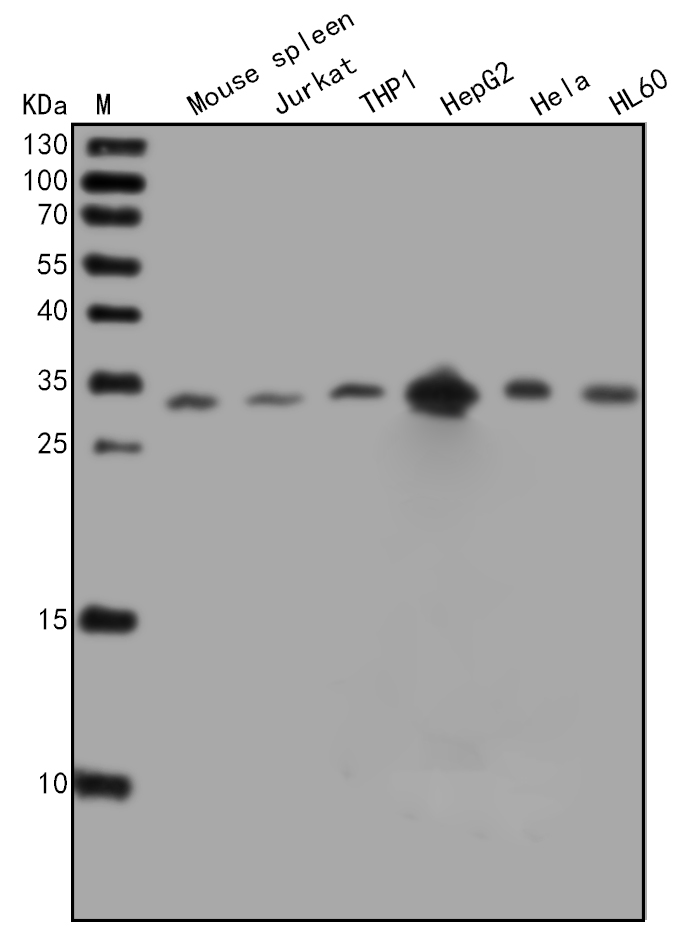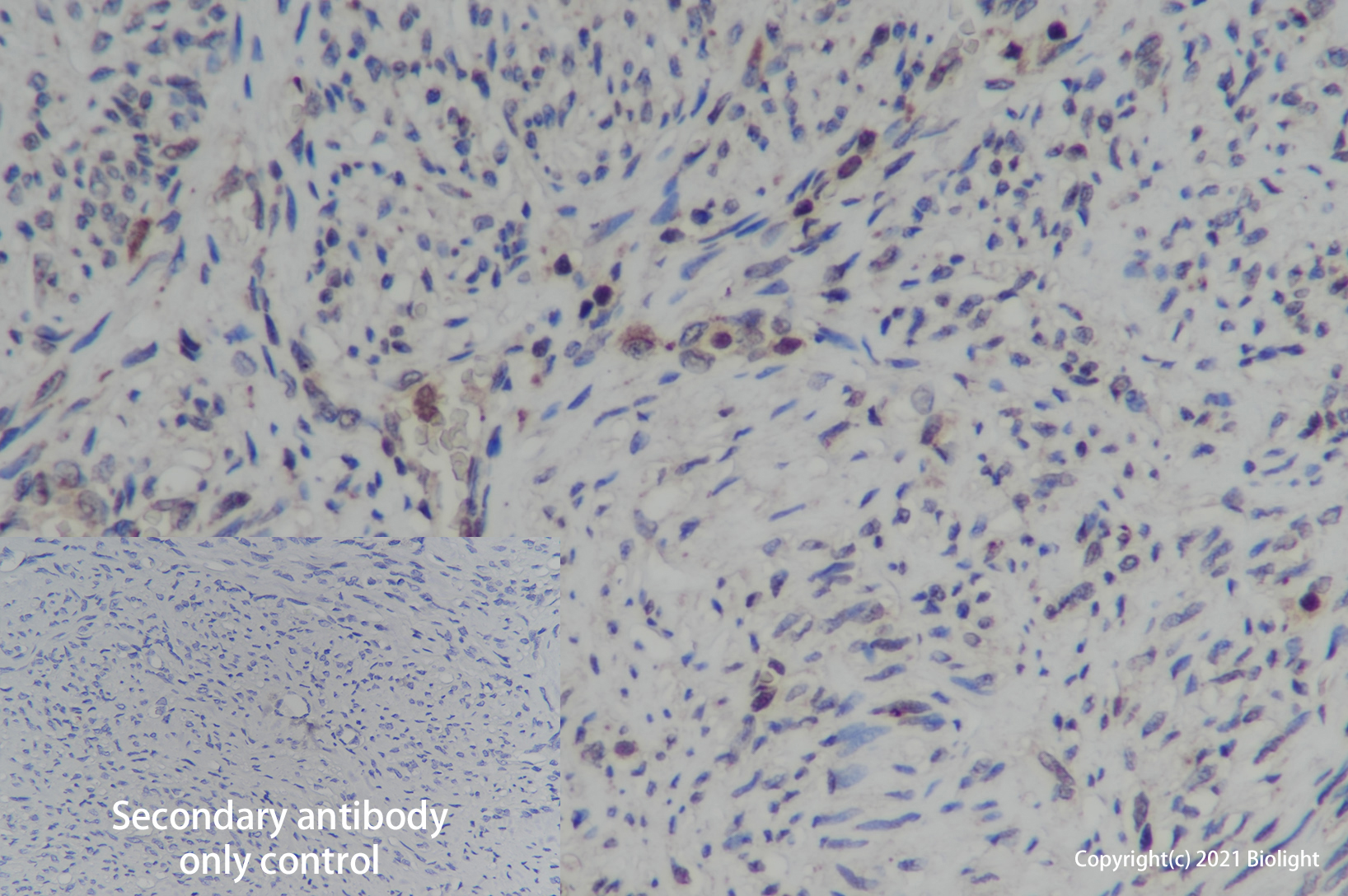
产品名称:Anti-CASP3 Antibody, Rabbit Polyclonal
经验证的应用:WB/IHC/IF/ICC
交叉反应:Hu/Mu
特异性:human CASP3
免疫原:Recombinant human CASP3 protein, fragment Ser29~Asp175; UniprotKB: p42574
制备方法:Produced in rabbits immunized with human CASP3, and purified by antigen affinity chromatography.
来源:Polyclonal Rabbit IgG
纯化:Immunogen affinity purified
缓冲液:Supplied in PBS, 50% glycerol and less than 0.02% sodium azide, PH7.4
偶联物:Unconjugated
状态:Liquid
运输方式:This antibody is shipped as liquid solution at ambient temperature. Upon receipt, store it immediately at the temperature recommended.
储存条件:This antibody can be stored at 2℃-8℃ for one month without detectable loss of activity. Antibody products are stable for twelve months from date of receipt when stored at -20℃ to -80℃. Preservative-Free. Avoid repeated freeze-thaw cycles.
图片:
Figure1.Western blot analysis of extracts of various cell lines and tissues , using CASP3 antibody (PA00067HuA10) at 2ug/ml dilution.Secondary antibody: HRP Goat Anti-Rabbit IgG (H+L) at 1:10000 dilution.Blocking buffer: 5% nonfat dry milk in TBST.
Figure2.Immunohistochemistry (Formalin/PFA-fixed paraffin-embedded sections) analysis of human tonsil sections labelling CASP3 with purified PA00067HuA10 at 10ug/ml. Heat mediated antigen retrieval was performed using EDTA buffer (pH 9.0). Tissue was counterstained with Hematoxylin. Rabbit specific IHC polymer detection kit HRP/DAB secondary antibody was used at 1/4000 dilution. PBS instead of the primary antibody was used as the negative control.
Figure3.Immunohistochemistry (Formalin/PFA-fixed paraffin-embedded sections) analysis of human cervical cancer sections labelling CASP3 with purified PA00067HuA10 at 10ug/ml. Heat mediated antigen retrieval was performed using EDTA buffer (pH 9.0). Tissue was counterstained with Hematoxylin. Rabbit specific IHC polymer detection kit HRP/DAB secondary antibody was used at 1/4000 dilution. PBS instead of the primary antibody was used as the negative control.
别称:CPP32, CPP32B, SCA1, Apoptain, Yama, Apoptosis-Related Cysteine Peptidase, Cysteinyl Aspartate Specific Proteinases 3, SREBP cleavage activity 1
背景信息:Caspase-3. Caspase-3 (Cysteine-aspartic acid protease 3/Casp3; also Yama, apopain and CPP32) is a 29 kDa member of the peptidase C14A family of enzymes (1, 2, 3). It is widely expressed and is an integral component of the apoptotic cascade. Caspase-3 is considered to be the major executioner caspase; that is, the primary downstream mediator of apoptotic-associated proteolysis (2, 3, 4). Active Caspase-3 is known to utilize a Cys residue to cleave multiple substrates, including PARP, proIL‑16, PKC-gamma & -δ, procaspases 6, 7 and 9, and beta ‑catenin (1). Human procaspase-3 is a 32 kDa, 277 amino acid (aa) protein (5, 6, 7). Normally, it is an inactive, cytosolic homodimer, but following an upstream signal that activates processing proteases, procaspase-3 undergoes proteolytic cleavage (1, 2, 8, 9). This generates an N-terminal 175 aa p20/20 kDa subunit plus a 102 aa C-terminal p12/12 kDa subunit, followed by further processing of the p20 subunit at Asp28 to generate a final p17 subunit (aa 29‑175) (9). The p17 and p12 subunits noncovalently heterodimerize, and subsequently associate with another p17/p12 heterodimer to form an active antiparallel homodimer. The p17 subunit contains the enzyme active site (aa 161‑165), with an embedded catalytic Cys which is normally nitrosylated and inactive. Full activation requires both proteolytic processing and Cys163 denitrosylation (10). Multiple proteases can use Caspase-3 as a substrate including Caspase-6, -8, and -10, granzyme B, and Caspase-3 itself (9, 11, 12, 13).
全称:Caspase-3 (CASP3)
经验证的应用:WB/IHC/IF/ICC
交叉反应:Hu/Mu
特异性:human CASP3
免疫原:Recombinant human CASP3 protein, fragment Ser29~Asp175; UniprotKB: p42574
制备方法:Produced in rabbits immunized with human CASP3, and purified by antigen affinity chromatography.
来源:Polyclonal Rabbit IgG
纯化:Immunogen affinity purified
缓冲液:Supplied in PBS, 50% glycerol and less than 0.02% sodium azide, PH7.4
偶联物:Unconjugated
状态:Liquid
运输方式:This antibody is shipped as liquid solution at ambient temperature. Upon receipt, store it immediately at the temperature recommended.
储存条件:This antibody can be stored at 2℃-8℃ for one month without detectable loss of activity. Antibody products are stable for twelve months from date of receipt when stored at -20℃ to -80℃. Preservative-Free. Avoid repeated freeze-thaw cycles.
图片:
Figure1.Western blot analysis of extracts of various cell lines and tissues , using CASP3 antibody (PA00067HuA10) at 2ug/ml dilution.Secondary antibody: HRP Goat Anti-Rabbit IgG (H+L) at 1:10000 dilution.Blocking buffer: 5% nonfat dry milk in TBST.
Figure2.Immunohistochemistry (Formalin/PFA-fixed paraffin-embedded sections) analysis of human tonsil sections labelling CASP3 with purified PA00067HuA10 at 10ug/ml. Heat mediated antigen retrieval was performed using EDTA buffer (pH 9.0). Tissue was counterstained with Hematoxylin. Rabbit specific IHC polymer detection kit HRP/DAB secondary antibody was used at 1/4000 dilution. PBS instead of the primary antibody was used as the negative control.
Figure3.Immunohistochemistry (Formalin/PFA-fixed paraffin-embedded sections) analysis of human cervical cancer sections labelling CASP3 with purified PA00067HuA10 at 10ug/ml. Heat mediated antigen retrieval was performed using EDTA buffer (pH 9.0). Tissue was counterstained with Hematoxylin. Rabbit specific IHC polymer detection kit HRP/DAB secondary antibody was used at 1/4000 dilution. PBS instead of the primary antibody was used as the negative control.
别称:CPP32, CPP32B, SCA1, Apoptain, Yama, Apoptosis-Related Cysteine Peptidase, Cysteinyl Aspartate Specific Proteinases 3, SREBP cleavage activity 1
背景信息:Caspase-3. Caspase-3 (Cysteine-aspartic acid protease 3/Casp3; also Yama, apopain and CPP32) is a 29 kDa member of the peptidase C14A family of enzymes (1, 2, 3). It is widely expressed and is an integral component of the apoptotic cascade. Caspase-3 is considered to be the major executioner caspase; that is, the primary downstream mediator of apoptotic-associated proteolysis (2, 3, 4). Active Caspase-3 is known to utilize a Cys residue to cleave multiple substrates, including PARP, proIL‑16, PKC-gamma & -δ, procaspases 6, 7 and 9, and beta ‑catenin (1). Human procaspase-3 is a 32 kDa, 277 amino acid (aa) protein (5, 6, 7). Normally, it is an inactive, cytosolic homodimer, but following an upstream signal that activates processing proteases, procaspase-3 undergoes proteolytic cleavage (1, 2, 8, 9). This generates an N-terminal 175 aa p20/20 kDa subunit plus a 102 aa C-terminal p12/12 kDa subunit, followed by further processing of the p20 subunit at Asp28 to generate a final p17 subunit (aa 29‑175) (9). The p17 and p12 subunits noncovalently heterodimerize, and subsequently associate with another p17/p12 heterodimer to form an active antiparallel homodimer. The p17 subunit contains the enzyme active site (aa 161‑165), with an embedded catalytic Cys which is normally nitrosylated and inactive. Full activation requires both proteolytic processing and Cys163 denitrosylation (10). Multiple proteases can use Caspase-3 as a substrate including Caspase-6, -8, and -10, granzyme B, and Caspase-3 itself (9, 11, 12, 13).
全称:Caspase-3 (CASP3)



